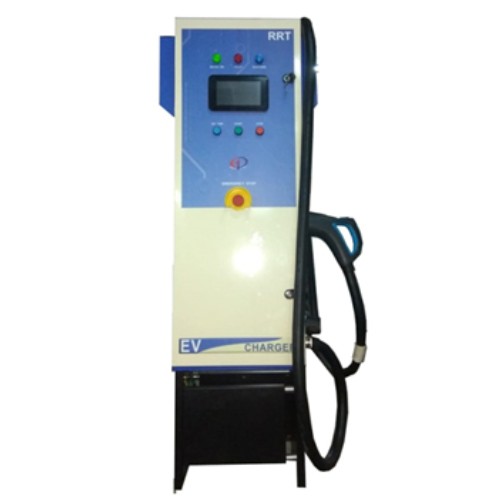Schedule a Call Back
By 2032 India will have 123 million EVs on-road under NEV goal
 Industry News
Industry News- May 06,25

In a significant move towards sustainable development and to achieve net zero emissions by 2070, there is a need to adopt electric vehicles (EVs), this can bolster India’s economy while supporting the ambitious target set for 2030—EV penetration of 30%. With robust government policies and an R&D landscape, India’s electric vehicle (EV) momentum is impossible to ignore. The report, titled ‘India Electric Vehicle Charging Infrastructure Market Overview’, by IESA (India Energy Storage Alliance) and CES (Customized Energy Solutions), outlines the potential impact of this transition on the country's infrastructure and energy landscape. According to the report, India is set to see a notable surge in electric vehicles, with an estimated 123 million EVs projected to be on the roads by 2032. This remarkable growth aligns with the National EV Targets (NEV) scenario, highlighting the nation's commitment to boosting sustainable transportation and reducing carbon emissions.
-------------------------------------------------------------
Photo Credit: Freepik
The report
estimates that India's cumulative on-road lithium-ion electric vehicle (EV)
population increased nearly twelvefold, rising from 0.35 million in 2019 to 4.4
million in 2024. This rapid growth has been fuelled by supportive government
policies, such as the FAME-II scheme, which offers demand incentives for
electric two-wheelers, three-wheelers, and four-wheelers, along with capital
subsidies for public charging infrastructure. It further highlighted that
electric two and three-wheelers together accounted for over 93% of India's
on-road EV stock in 2024. In contrast, electric four-wheelers represented
around 6%, while electric buses and trucks comprised less than 1%. Notably, the
personal electric four-wheeler (E4W) segment has emerged as a key driver of the
country's expanding private and home charging ecosystem.
Vinayak
Walimbe, Managing Director, Customized Energy Solutions India Pvt Ltd says, “By 2032, IESA and CES projects that India’s on-road EV stock could
reach approximately 49 million (Worst Case), 60 million (Business-as-Usual), or
123 million (NEV scenario). The NEV scenario is based on the EV30@30 ambition,
assuming that by 2030, EV penetration reaches 80% for electric two- and
three-wheelers, 30% for private electric four-wheelers, 70% for commercial
cars, and 40% for electric buses—fully aligning with NITI Aayog’s vision for
transport electrification.”
As per the
report, in 2024, there were approximately 220,000 personal electric
four-wheelers (E4Ws) on roads, most of which depended on Type-2 AC chargers
installed in residential areas. By that same year, India had an estimated
320,000 private Type-2 AC chargers, with 70% being 3.3 kW units, 28% 7.4 kW
units, and the remaining 11-22 kW units classified as high-capacity. India had
roughly 76,000 cumulative public and captive charging points in 2024, with a
combined installed capacity of 1.3?GW. While AC-001 chargers made up nearly half of
all installed points, the overall installed capacity was dominated by CCS2
chargers, reflecting the growing demand for high-power DC fast charging.
Debmalya
Sen, President, IESA said, " To
support the projected EV growth, we can anticipate that India’s cumulative
installed EV charging points—public and captive—will need to grow nearly 12 to
28 times, from around 76,000 in 2024 to between 0.9 million and 2.1 million by
2032. Installed charging capacity must also scale more than 17 times, rising
from 1.3?GW to 23?GW, depending on EV adoption and infrastructure utilisation levels.”
By 2032,
the projected stock of electric vehicles (EVs) is expected to reach
approximately 4.3 million, 5.8 million, and 10 million electric four-wheelers
under the Worst Case, Business as Usual (BAU), and New Energy Vehicle (NEV)
scenarios, respectively. In addition, electric buses and trucks could grow to
around 450,000, 750,000, and 1.1 million units. These two segments are crucial
drivers of demand for both captive and public charging infrastructure,
particularly for high-power DC fast charging.
Driven by supportive government policies and incentives, this growth underscores a commitment to sustainable development and reduced carbon emissions. However, to accommodate this surge, India must significantly expand its charging infrastructure, increasing from 76,000 points in 2024 to between 0.9 million and 2.1 million by 2032. With strategic investments and policy support, India is set to emerge as a leader in electric mobility, fostering both environmental sustainability and economic growth.
Related Stories

Can India’s Exports Takeoff Amid Global Market Uncertainty?
India's merchandise exports are navigating a complex global landscape marked by economic and geopolitical turbulence, including trade wars. India needs to take multiple measures to build a resilient..
Read more
Why efficient material handling is essential for the success on Make in India
Indian manufacturers need well-managed warehouses amid global disruptions (like tariff wars and geopolitical tensions) to reduce costs and avoid delays. Hence, efficient material handling systems ar..
Read more
Indian auto component industry expects 8-10% growth in FY25: Vinnie Mehta
In this interaction with Rakesh Rao, Vinnie Mehta, Director General of Automotive Component Manufacturers Association of India (ACMA), presents his views on the impact of recent global events on Ind..
Read moreRelated Products
Tata Motors unveils facilities for development of Hydrogen propulsion tech
Tata Motors, India?s largest automobile company, unveiled two state-of-the-art & new-age R&D facilities for meeting its mission of offering sustainable mobility solutions. The unveilings constitute of Read more
Tata Motors plans petrol powertrain for Harrier and Safari SUVs
Tata Motors is in the process of developing a new petrol powertrain for its premium sports utility vehicles, the Harrier and Safari, as confirmed by a senior company official. Currently, these models Read more

Electric Vehicle Charger
RRT Electro is engaged in manufacturing of customized Power Electronic Products over two decades having capability to Design, Develop, Prototyping, Regulatory Compliance testing & Certification, Manuf Read more













